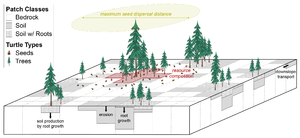2021 CSDMS meeting-134
From CSDMS
Log in (or create account for non-CSDMS members)
Forgot username? Search or email:CSDMSweb@colorado.edu
Browse abstracts
Coupling an Agent-Based Model of forest dynamics and soil production to sediment transport models in Landlab
Matthew Rossi, University of Colorado, Boulder Boulder Colorado, United States. matthew.rossi@colorado.edu
Gregory Tucker, University of Colorado, Boulder Boulder Colorado, United States. gtucker@colorado.edu
Suzanne Anderson, University of Colorado, Boulder Boulder Colorado, United States. Suzanne.Anderson@colorado.edu
Robert Anderson, University of Colorado, Boulder Boulder Colorado, United States. Robert.S.Anderson@colorado.edu
Landscape evolution studies typically simulate long-term soil development by varying production rates as a function of the local thickness of soil. Whether this function monotonically decreases with increasing soil depth remains an active source of debate. In modest relief landscapes, the presence of isolated bedrock outcrops called tors are often used to argue for the so-called ‘humped’ soil production function, which hypothesizes that there is an optimal, non-zero soil depth for soil production. Furthermore, in many steep landscapes, the fraction of bedrock exposed at the surface can be very high where cliffs bands form in response to high erosion rates. Yet, numerical models of hillslope evolution struggle to reproduce the continuous transition from fully soil-mantled to bedrock-dominated hillsides within a single framework. To address this, we present a new Agent-Based Model (ABM) of forest dynamics and soil production that is coupled to continuum-based models of hillslope sediment transport (i.e., linear and nonlinear creep). In this model, tors and bedrock cliffs are emergent features that manifest even when maximum possible soil production rates occur at zero soil depth. The intermittency of seed germination and sapling recruitment on bare bedrock surfaces combined with the rapid downslope transport of newly developed soil facilitates the persistence of exposed bedrock. By linking soil development to plant functional type, this work also shows how soil depths and bedrock exposure patterns that evolve over millennia may be mechanistically linked to forest properties that stabilize over shorter timescales. To illustrate model behavior, we use plant parameters inspired by Pinus ponderosa, the dominant species observed at low to intermediate montane forests in the Colorado Front Range. Using this as a baseline, we then test model sensitivity to a variety of tree functional parameters including seed fecundity, seed dispersal distance, maximum rooting depth, and maximum individual lifespans. Our work is the first to couple a NetLogo ABM to Python-based Landlab via the pyNetLogo library. As such, this use-case serves as a template for other landscape evolution studies targeting feedbacks among biological agents, substrate properties, and sediment transport.
| Concept diagram for the numerical model used to simulate hillslope evolution. Forest dynamics and soil production are simulated using a NetLogo ABM and coupled to Landlab via the pyNetLogo library. |

